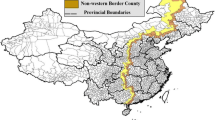Abstract
Over the past few decades, many counties have adopted development impact fees as an alternative to traditional tax funding for infrastructure required to support new development. In a theoretical model of firm entry using fixed costs and increasing returns to scale, additional fees, modeled as an increase in fixed costs, reduces the number of entrants and increases a firm’s size. Using county level data on homogenous, small draw area firms in Florida, the research presented in this paper suggests that fees reduce the number of firms per capita in a jurisdiction. While population and market size are the main drivers of firms’ location decisions, the results presented in this paper suggest that fees may have a negative effect on firm location decisions at the margin. Policy makers concerned about employment and commercial tax base should give pause before implementing a fee system.
Similar content being viewed by others
Notes
While Bresnahan and Reiss modeled firm entry and not the number of firms in equilibrium, their model is still instructive for thinking about the number of firms in a more static model.
These firms were chosen for their assumedly small customer draw areas.
More precise conclusions could be drawn with a panel dataset and fee levels rather than a binary variable, however, such data is not consistently available for all the variables over the almost 40 years fees have been in use.
To more confidently address causation a panel analysis consisting of a larger cross section and potentially decades of time series would be needed. However, the cross sectional analysis here is supportive of the theoretical model presented above.
References
Bresnahan, T. F., & Reiss, P. C. (1991). Entry and competition in concentrated markets. Journal of Political Economy, 99(5), 977–1009.
Brueckner, J. K. (1997). Infrastructure financing and urban development: the economics of impact fees. Journal of Public Economics, 66(3), 383–407.
Burge, G. S. (2005). A theoretical and empirical investigation of the effects of impact fees on the affordability of starter homes. Tallahassee: Florida State University.
Burge, G., & Ihlanfeldt, K. (2006). Impact fees and single-family home construction. Journal of Urban Economics, 60, 284–306.
Burge, G., & Ihlanfeldt, K. (2009). Development impact fees and employment. Regional Science and Urban Economics, 21(3), 54–62.
Ihlanfeldt, K. R., & Shaughnessy, T. M. (2004). An empirical investigation of the effects of impact fees on housing and land markets. Regional Science and Urban Economics, 34(6), 639–661.
Jeong, M.-G. (2006). Local choices for development impact fees. Urban Affairs Review, 41(3), 335–357.
Jeong, M.-G., & Feiock, R. C. (2006). Impact fees, growth management, and development: a contractual approach to local policy and governance. Urban Affairs Review, 41(6), 749–768.
Jones, A. T. (2013). Mileage tax, property tax, sales tax, or fee: The best way to pay for commercial infrastructure that isn’t free. Working Paper.
Jones, A. T., & Snow, A. (2015). A normative analysis of impact fees for suburban commercial development. FinanzArchiv, 71(2).
Mullen, C. (2012). National impact fee survey 2012. Austin, TX: Duncan Associates. Retrieved from Impact Fees - Surveys: impactfees.com.
Nelson, A. C., and Moody, M. (2003). Paying for propserity: Impact fees and job growth. Brookings Institution Center on Urban and Metropolitan Policy. http://www.brookings.edu/research/reports/2003/06/metropolitanpolicy-nelson
Powell, L. M., Chaloupka, F. J., & Bao, Y. (2007). The availability of fast-food and full-service restaurants in the United States. American Journal of Preventitive Medicine, 33(4s), 240–245.
Yinger, J. (1998). The incidence of development impact fees and special assessments. National Tax Journal, 51, 23–42.
Author information
Authors and Affiliations
Corresponding author
Rights and permissions
About this article
Cite this article
Jones, A.T. Fees and Firms: An Empirical Examination of the Relationship Between Development Impact Fees and Firms. Atl Econ J 43, 261–269 (2015). https://doi.org/10.1007/s11293-015-9453-7
Published:
Issue Date:
DOI: https://doi.org/10.1007/s11293-015-9453-7




